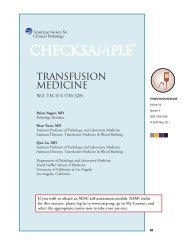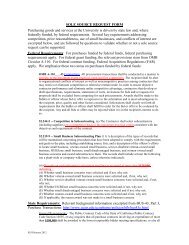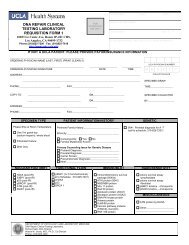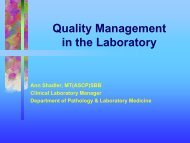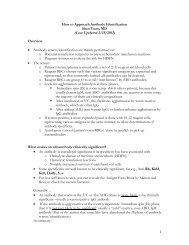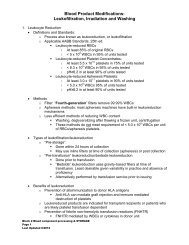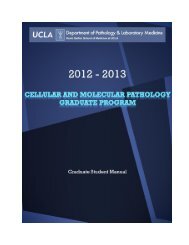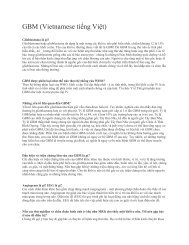Introduction to Therapeutic Apheresis. by S Yuan, last updated 6/22 ...
Introduction to Therapeutic Apheresis. by S Yuan, last updated 6/22 ...
Introduction to Therapeutic Apheresis. by S Yuan, last updated 6/22 ...
- No tags were found...
You also want an ePaper? Increase the reach of your titles
YUMPU automatically turns print PDFs into web optimized ePapers that Google loves.
<strong>Therapeutic</strong> <strong>Apheresis</strong>An OverviewShan <strong>Yuan</strong>June, 2011
What is <strong>Therapeutic</strong> <strong>Apheresis</strong>?• <strong>Apheresis</strong>• Greek: To take away• Modern: Separation and selective removal, exchange or modification of a bloodcomponent• Usually performed with au<strong>to</strong>mated instruments• Donor <strong>Apheresis</strong>• Single component collection (RBCs, plasma, platelets, or WBCs) from healthydonors• Multi-component: a combination of components, e.g. plasma + platelets• <strong>Therapeutic</strong> Aphereis• A component in the blood is thought <strong>to</strong> contribute <strong>to</strong> a disease state, for example• Component is removed, exchanged or modified in order <strong>to</strong> achieve therapeutic purposes
What Does <strong>Therapeutic</strong> <strong>Apheresis</strong>Accomplish?• Removal of:• WBCs:• Leukocytapheresis: in the setting of high WBC count in leukemia• Peripheral stem cell collection• Platelets:• Thrombocytapheresis for thrombocy<strong>to</strong>sis of myeloproliferativedisorders• Exchange of:• RBC: Erythrocytapheresis (sickle cell disease, malaria)• Plasma: therapeutic plasma exchange (TPE):• “Pro<strong>to</strong>type” of therapeutic exchange procedures• Removal of antibodies, paraproteins, cholesterol,• Modification of:• WBC (with UV light): Pho<strong>to</strong>pheresis
<strong>Apheresis</strong> Instrument Types• Centrifugation• Baxter/Fenwal CS 3000• Gambro/BCT(Caridian)Cobe Spectra• Haemonentics MCS+• Membrane• Asahi PlasmaFlo• Gambro BCT(Caridian)Prisma TPE• Adsorption Column(Selective removal)
the Bank of Japan) during 2001-04. After a prolonged period of economic stagnationcharacterized <strong>by</strong> low economic growth and deflation, in March 2001, the Bank of Japan(BOJ) adopted what became known as the quantitative easing monetary policy (QEMP). Itconsisted of three pillars: (i) the BOJ supplied ample liquidity <strong>by</strong> using the deposits ofcommercial banks held at the central bank (current account balances, or CAB)—acomponent of the monetary base—as the main operating target; (ii) it publicly committeditself <strong>to</strong> maintaining ample liquidity until core consumer price index (CPI) inflation becamezero or higher on a sustained basis; and (iii) it increased the purchases of Japanesegovernment bonds (JGBs) <strong>to</strong> inject liquidity (see Maeda et al. 2005 for technical details).For the period of QEMP as a whole, the Ministry of Finance (MOF) intervened inthe foreign exchange market over 130 times (using its own balance sheet, but actingthrough the Bank of Japan as its agent), with a cumulative sale of about 42 trillion yen(about $380 billion). While the MOF’s policy at the outset of the QEMP period was <strong>to</strong>intervene decisively but infrequently, the intervention tactic changed in January 2003 whenintervention became both frequent and large-scale (Figure 1). During the 15-month periodof the so-called “great intervention” (from January 2003 through March 2004), 3 theauthorities sold for US dollars a cumulative sum of 35 trillion yen, an amount equivalent <strong>to</strong>7 percent of Japan’s annual GDP. In 2003 and 2004, the purchases of foreign assets <strong>by</strong> the3 In Japan, the great intervention has also been named as the Mizoguchi-Taylor intervention after ZenbeiMizoguchi and John B. Taylor who were at the time largely responsible for making or condoning theJapanese government’s intervention decisions as Japanese Vice Minister of Finance and US TreasuryUndersecretary, respectively. Taylor explained that <strong>by</strong> “adopting a more <strong>to</strong>lerant position <strong>to</strong>wardintervention—especially if it went unsterilized” the US position was <strong>to</strong> “help <strong>to</strong> increase the money supply inJapan” (Taylor 2007, p.286). The <strong>22</strong> March 2004 issue of Business Week magazine, calling Mizoguchi “Mr.Dollar,” described him as “a faceless bureaucrat in a <strong>to</strong>wn full of them [who] enjoys celebrity status” intrading pits in London and New York.- 2 -
Process Overview• Blood is drawn from patient• Blood is immediately mixed with an anticoagulant (typicallyat 1:10 <strong>to</strong> 1:14 anticoagulant <strong>to</strong> whole blood ratio)• Anticoagulated blood pumped in<strong>to</strong> a bowl/belt chamber• Blood components separated <strong>by</strong> centrifugation according<strong>to</strong> their specific gravities• Plasma/RBC interface maintained at steady state• Desired component harvested /removed through outgoingtubes• Replacement fluid added <strong>to</strong> the remaining components ifplasma is removed• Other components returned <strong>to</strong> the patient
Overview of Plasma Exchange Circuit
Intermittent vs. Continuous Flow• Intermittent flow: procedure performed in cycles (withdrawal,separate, re-infuse).• Pro: one needle access for peripheral access• Con: extracorporeal volume (ECV) can be high (bad in kids andthe elderly with low <strong>to</strong>tal blood volume or TBV), fluctuations inhemodynamics• E.g: Haemonetic V50• Continuous flow: blood withdrawn, processed and reinfusedsimultaneously• Pro: smaller ECV, hemodynamic stability, faster• Con: 2 venipuncture sites for peripheral access• Examples: COBE Spectra, Fenwal C3000 Plus, Fresenius AS104
Membrane Filtration• Conceptually similar <strong>to</strong>hemodialysis• Use limited <strong>to</strong> plasmaexchange• Blood is pumped <strong>to</strong> the filtermembrane• Membranes with pore sizesthat can trap high MWproteins, exclude cellularelements• Cellular componentscombined with replacementfluid, returned <strong>to</strong> patient
Liposorber (Kaneka)
Prosorba• Staphylococcal protein A bound<strong>to</strong> silica beads in the column• Removes free IgG as well asimmune complexes <strong>by</strong> binding <strong>to</strong>the Fc portion of IgG• May have immune modula<strong>to</strong>ryeffects• FDA approved for treatment ofrefrac<strong>to</strong>ry ITP and rheuma<strong>to</strong>idarthritis• Limited efficacy in ITP and RF• No longer manufactured.
Anticoagulant: Citrate and CitrateToxicity• Acid Citrate Dextrose (ACD)• Most commonly used anticoagulant for apheresis• Citrate ion chelates free Ca++ ions and blocks calciumdependentcoagulation cascade• Ensures that extracorporeal blood remains in a fluid state• Pros:• Ubiqui<strong>to</strong>us compound found in all human cells, not “foreign”• Metabolized <strong>by</strong> liver quickly <strong>to</strong> bicarbonate, little systemic effect• Cons:• Can cause transient systemic hypocalcemia(citrate <strong>to</strong>xicity),presenting with numbness, peri-oral tingling, tetany, cramping,EKG changes
Anticoagulant: Citrate and CitrateToxicity• Citrate <strong>to</strong>xicity exacerbated <strong>by</strong> :• Patient receiving additional citrate load due <strong>to</strong> infusion of FFP• Patient also receiving albumin as replacement fluid, which bindsCa++• Fast rate of infusion/return• Longer duration of the procedure• Pre-existing hypocalcemia• Treat/Prevent By• Oral/IV calcium supplementation before or during the procedure• Increase whole blood <strong>to</strong> citrate ratio• Slower infusion rate• S<strong>to</strong>p the procedure
Anticoagulant: Heparin• Prevents clotting <strong>by</strong> potentiating antithrombin’s activity <strong>by</strong> 1000x• Used alone or in combination with citrate• Required/preferred <strong>by</strong> some instruments (Liposorber LDL,pho<strong>to</strong>pheresis instrumentsmembrane filtration)• Degree of anticoagulation similar <strong>to</strong> DVT prophylaxis (plasmaconcentration 0.5 <strong>to</strong> 2.0 IU/ml)• Pro: reduce citrate dose, avoid hypocalcemia• Con:• Short term systemic anticoagulation• Risk of inducing HIT• Reverse overdose with protamine
Fluid Shifts• Fluid shifts can occur when• When blood is removed in the beginning of a procedure• A blood component is selectively removed• Other components/replacement fluid infused• Associated with risks of hypovolemic andvasovagal reactions• Newer instruments(continuous flow) attempts <strong>to</strong>achieve gentler fluctuations in fluid
Fluid Shifts• To minimize the risk of hypovolemia, limit thepatients extracorporeal (ECV) <strong>to</strong>
Replacement Fluid for <strong>Therapeutic</strong>Plasma Exchange (TPE)• Several liters of plasma can be removed• Volume deficit needs <strong>to</strong> be replaced <strong>by</strong> fluidinfusion.• Options:• Crystalloid (normal saline)• Colloid (albumin)• Plasma
Replacement Fluid for TPE• Crystalloid (normal saline)• Pros:• Cheap,• No infectious/allergic risks• Readily available• Cons:• Hypo-oncotic, only ~1/3 stays intravascular, this may lead <strong>to</strong>intravascular fluid deficit, hypotension.• Therefore usually used in combination with albumin: startprocedure with NS replacement, then finish with albuminrepalcement• Lacks coagulation fac<strong>to</strong>rs/ immunoglobulins
Replacement Fluid for TPE• Albumin (5%) (Used for most indications of TPE)• Pros:• Colloid, iso-oncotic stays intravascular,• No <strong>to</strong> very, very low allergic/ infectious risks• Cons:• Does not replace other protein fractions, such as coagulation fac<strong>to</strong>r• Expensive• Not always available, periodic national shortages of albumin canoccur
Replacement Fluid for TPE• Plasma• Pros•• Iso-oncotic• Replaces coag fac<strong>to</strong>rs, immunoglobulins and other plasma proteins• Cons• Infectious and allergic risks• Additional citrate load, increases risk of hypocalcemia• TRALI risks• Needs <strong>to</strong> be ABO compatible• Expensive• Indications:• Thrombotic thrombocy<strong>to</strong>penic purpura (TTP) <strong>to</strong> replace ADAMTS-13• Replacing coag fac<strong>to</strong>rs in liver failure, or in patient undergoingrepeated daily TPE procedures with albumin as replacement fluid
Vascular Access: Peripheral vs.Central• Peripheral access• Use peripheral veins for access (antecubital, femoral)• Need large needle for both the draw (16g) and returnlines (19g), <strong>to</strong> allow flow rate between 60-120ml/min foradults• Patient needs <strong>to</strong> have reasonable muscular <strong>to</strong>ne <strong>to</strong>maintain blood flow (ie. Squeeze/pump when asked)• Less invasive and faster <strong>to</strong> place• Good for:• Infrequent procedures• Pt with good veins and reasonable muscular <strong>to</strong>ne and whoare able <strong>to</strong> cooperate
Calculating Plasma Volume
Plasma Volume Exhanged vs. % ofDisease Media<strong>to</strong>rs Removed
Removal Efficiency of TPE• Depends on• Volume removed relative <strong>to</strong> the patient <strong>to</strong>tal plasma volume• Proportion of the pathogenic substance that stays intravascular• Rate of replenishment of the pathogenic substance <strong>by</strong> synthesisor re-equilibration with the extravascular/intracellular space• For example: IgG only 50% intravascular, re-equilibrates readily,therefore reduction is transient after a single exchange. Frequentdaily or every other day plasma exchange usually required.• IgM largely intravascular, re-equilibrates and is synthesized slowly,therefore removed much more efficiently.
Effects of Plasma Exchange• Electrolytes and small molecules like glucose: small and verytransient decrease because of rapid equilibration• Drugs: depends on volume of distribution, dosing schedule• Proteins: recovery depends on synthesis and redistribution• Complement, coag fac<strong>to</strong>rs: return <strong>to</strong> baseline 24-72 hours• Antibodies:• Variably removed. Increased infection rarely observed• Rebound phenotmenon: TPE may actually stimulate a transientincrease in synthesis
Constituent %Removed % Recoveredat 48 hrs• Clotting fac<strong>to</strong>rs 25 – 50 80 – 100• Fibrinogen 63 65• Immune globulins 63 45• Paraproteins 20 – 30 Variable• Liver Enzymes 55 – 60 100• Bilirubin 45 100• C3 63 60 – 100• Platelets 25 – 30 75 – 100
Coagulation Status• Due <strong>to</strong> removal of coag proteins, immediately postexchange with albumin, will see prolonged PT, aPTT↑,and low fibrinogen• However, bleeding complications are rare in patientswithout pre-existing coagulopathy• With redistribution/synthesis, most coag fac<strong>to</strong>rsnormalizes <strong>to</strong> hemostatic levels within hours• Avoid coag testing immediately following TPE, moreinformative if wait until next morning, or before the nextprocedure
Coagulation Status: FFP Needed?• Routine supplementation with FFP not necessary formost patients• Fibrinogen replaced most slowly (but this is variabledepending on patient –Fg is an acute phase reactant,elevated in many patients• If consecutive TPE’s with albumin replacement areperformed, check fibrinogen. If falls
Effects of Plasma Exchange-Cells• Cells:• Platelets can drop up <strong>to</strong> 33% after one single plasmavolume exchange, up <strong>to</strong> 75% with multiple dailyprocedures.• Returns <strong>to</strong> baseline within 2-3 days• Sequestered platelets can be released from spleenpost exchange and help count recovery• Platelet count should be moni<strong>to</strong>red in patientundergoing multiple procedures• Transfusions rarely necessary
Adverse Reactions• Overall rate 4-5%, higher with the firstprocedure• Types of adverse reactions• Transfusion reactions• Citrate <strong>to</strong>xicity• Hypotension/Vasovagal• Access related complications• Infection• Hema<strong>to</strong>ma• Pneumothorax• etc
Adverse Reactions• Rate Varies depending on the type of procedure• RBC exchange 10.3%• TPE with FFP: 7.8%• TPE with albumin 3.4%• Leukophereisis: 7.8%• Au<strong>to</strong>logous stem cell collection: 1.7%• Death is rare usually due <strong>to</strong> underlying disease• Reported <strong>to</strong> be 1-2 per 10,000 in the FrenchRegistry.• 0 cases reported in >20,000 cases reported <strong>to</strong> theSwedish registry
Citrate Toxicity• Citrate <strong>to</strong>xicity: symp<strong>to</strong>ms are due <strong>to</strong>hypocalcemia.• Mild: numbness and tingling• Severe: spasms (Chevostek’s and Trousseau’ssigns), tetany, seizure, EKG changes• Prevent and treat <strong>by</strong> :• Reduce flow/return rate• Increase WB <strong>to</strong> anticoagulation ratio• S<strong>to</strong>p procedure• Ca supplementation (oral, or IV 10% Ca gluconate) beforeor during
Other Adverse Effects• Allergic reactions: with FFP replacement primarily• Vasovagal/hypovolemic reactions: Associated with fluidshifts. Treat with positioning, fluid supplementation, haltingthe procedure• Anaphylac<strong>to</strong>id associated with ACE inhibi<strong>to</strong>rs• ACE inhibi<strong>to</strong>rs prevent metabolism of bradykiningenerated during procedure -> anaphylac<strong>to</strong>id reactions• Delay apheresis till 24-48h after <strong>last</strong> dose of ACE inhibi<strong>to</strong>r• Drug removal: Hold drugs >1 hour prior <strong>to</strong> and duringapheresis
Aphresis Indication Categories(ASFA/AABB)• Category I: First line therapy – proven <strong>to</strong> be effective• Category II: Adjunct therapy – proven <strong>to</strong> bebeneficial in some instances• Category III: May be- evidence is conflicting butthere is some suggestion of benefit, can beconsidered if conventional therapy is failing• Category IV: Lack of evidence that therapeuticapheresis is beneficial, anecdotal experiences havebeen discouraging• Category P: Pending
Category I Indications for TPE• Guillain Barre Syndrome• Chronic inflamma<strong>to</strong>ry demyelinatingpolyneuropathy (CIDP)• Myasthenia gravis• Goodpasture’s• Post-transfusion purpura• Refsum’s disease (faulty enzymes during thealpha-oxidation of phytanic acid resulting inbuildup of phytanic acid)• TTP
Other Indications of TPE• Rheuma<strong>to</strong>id arthritis• Major ABO incompatible marrow transplant• Presensitization <strong>to</strong> solid organ graft• Cryoglobulinemia• ITP• Ap<strong>last</strong>ic anemia• Au<strong>to</strong>immune hemolytic anemia• Hemolytic uremic syndrome• Hyperviscosity/multiple myeloma
Indications Cell Depletion Procedures• Category I• Hyperleukocy<strong>to</strong>sis• Thrombocy<strong>to</strong>sis• Others• Progressive MS• Polymyositis• Derma<strong>to</strong>myositis
Indications for RBC Exchanges• Category I:• Sickle cell disease (certain complications:• Acute chest syndrome• Stroke: prevention and treatment• Persistent priapism• Intractable pain crisis• Others:• Pro<strong>to</strong>zoa infections: malaria, babesia• Pre-op exchange for sickle cell patients• Rh negative young female who received Rh+ RBCs
Pho<strong>to</strong>pheresis: Procedure Overview
Pho<strong>to</strong>pheresis• Pho<strong>to</strong>activation results in crosslinking ofDNA strands in treated whitecells andsome protein changes• Mechanisms of action are hypothetical:• Apop<strong>to</strong>sis of malignant lymphocytes• Enhanced host immune response <strong>to</strong> malignantcells• General immune modula<strong>to</strong>ry effects (in GVHD)
Pho<strong>to</strong>pheresis Indications• Category I• Cutaneous T cell lymphoma• Others• Acute/Chronic GVHD following stem celltransplant• Heart transplant rejection
The End





